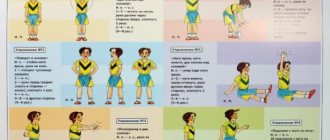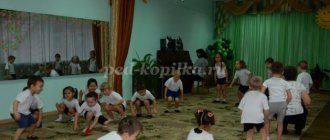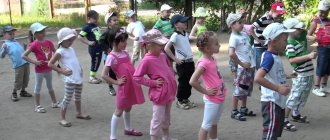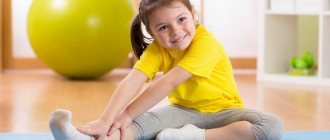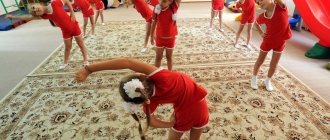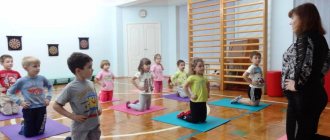The purpose of morning exercises
Morning exercises are physical exercises whose purpose is to increase the overall tone of the body. It gives you a boost of energy for the rest of the day. And your children's muscles become stronger.
From this we can conclude that its main purpose is to awaken your body and get a boost of energy for the rest of the day.
Which gymnastics complex is suitable for babies 6–9 months old?
At this age, the child tries to sit up - at first it is not very successful, but then he manages to master this important skill. From about 8 months he begins to crawl on his belly. Closer to 9 months, some children try to stand by their legs if there is suitable support nearby. Exercises for the development of a baby at this age are aimed at improving the listed skills, and here are some of them.
Exercise to strengthen your abdominal muscles
Place the baby on his back with his legs facing you. Grasp his shins with your hands, with your thumbs closer to the baby’s heels, and the rest resting on your knees. Without bending the legs, lift them to a vertical position, then lower them down. Repeat the exercise several times - it is aimed at training the abdominal muscles and establishing proper breathing.
An exercise that teaches a child to sit up independently
Place the baby on his back with his legs facing you. Let him wrap his hands around your index fingers and pull him towards you. Help the child sit up, then reverse the movement back to the starting position. Repeat the exercise several times. This simple children's gymnastics for toddlers trains the muscles of the shoulders, arms, abs and teaches them to sit up from a lying position.
Exercise to develop baby's crawling skills
Place the baby on his stomach with his legs facing you, bend them slightly at the knees. Place an interesting toy in front, within the baby’s visibility range - this way you motivate him to crawl, striving for an attractive goal. If the child does not understand the task, walk him back and forth several times, supporting him with your hand under the chest. This exercise is aimed at getting the baby to crawl and also trains a large number of muscles.
Exercise to strengthen your baby's back and teach him how to stand up
Place the baby on his stomach with his legs facing you. Place your index fingers in his hands and let him grab them. Slowly lift your fingers up, moving them back a little. If the baby is ready for this, he will kneel down and then try to rise to his feet. Repeat 1-2 times. Exercises of this kind are good for the legs and strengthen the muscles of the back and arms. But, most importantly, this is how the child learns to stand up correctly.
Charging at a preschool educational institution
For those who don't know what a dhow is. This is preschool education averaging, and in other words kindergarten.
In preschool institutions, physical education is held every day. Therefore, if your child goes to kindergarten, you may not exercise at home. However, on weekends or holidays you can continue to do the exercises.
What exercises are done in kindergarten? No matter what group your child is in, the exercises are always the same. It doesn’t matter if you’re in the middle group or the senior group.
General developmental. First they stretch their neck, shoulders, and arms. After the pelvis, knees, ankle. Circular rotations are performed.
Then we march in place. We squat, jump with our feet together and jump on one leg.
Mill exercise. Turn the torso to the sides.
When is the best time for a younger student to do exercises? How to prepare for gymnastics?
Man by nature must move a lot. It’s not for nothing that they say that movement is life. The less a child moves, spending all his free time near the TV and sitting at the computer, the more health problems he gets.
Children's specialists are sounding the alarm and reminding parents that children's bodies should be actively moving at least 10 hours a week, and for younger schoolchildren this minimum increases to 3 hours a day. Moreover, it is desirable that this happens in the fresh air.
Naturally, parents have too little time, but still dedicating 20 minutes in the morning and 20 minutes in the evening for exercise is not that difficult.
Exercises for morning exercises
Morning exercises for children. A set of 5 exercises will consist of: This is one of the quick activities so that if you oversleep, you can still complete the activity.
There are a number of exercises that are performed to musical songs. Namely, if you set a goal, you can find many songs that already tell you what to do. However, we will simplify the task for you and now we will write a set of exercises for beginners, consisting of 5 exercises. You can perform it to the music, so it will be much more interesting for your child to study.
- Walking in place
The main thing is to make sure that your legs are not too far apart. His hands were on his belt. The child must do the exercises correctly. Therefore, it is best to do everything next to him.
- Now that you have done the classic walk. Start walking with your knees high.
- Shallow squats with arms extended forward
This exercise helps strengthen your leg muscles and joints.
- Tilts
Feet shoulder-width apart, bend forward, right and left.
- Jumping on one leg
Hands on the belt. First, have your child jump on his left leg, then on his right.
Remember that charging does not take long. Maximum 20-30 minutes. And such as was written above, it takes only 10 minutes. Therefore, you don't need to do a lot of repetitions with a lot of approaches.
Morning exercises are called that because they are performed in the morning hours of the day. As a rule, immediately after waking up and has a complex effect on your body.
Therefore, it is necessary to do morning exercises in the morning.
The purpose and order of performing the exercises does not play any role. However, initially you should perform fairly gentle exercises. This way your body will warm up slightly and then you can do more active exercises.
Morning exercises in the senior group and elementary school are no different from each other. Except for the time. In kindergartens, children are not so diligent, so the amount of exercise is less. But in elementary school there are more exercises and they take longer. Below we will give an example of exercises that you can perform at any age and at any time. They can also be alternated.
Exercises for children in the preparatory group
- Bend forward towards your feet
Starting position: standing, legs together. We reach down with our hands to touch the floor or toes.
- Bend the torso to the sides
- Bend forward backward
Feet slightly wider than shoulder width, bend down towards your feet. The arms are straight, and then we stretch first forward and then back between the legs.
- Doing the splits
Full length portrait of happy young pregnant fitness model in sportswear, doing yoga, pilates training, Wide-Angle Seated Forward Bend pose, Upavishtha Konasana, white background, studio, isolated
We sit on the floor, spread our legs to the sides and alternately stretch, forward, right, left.
- fold
We connect the legs together. We continue to sit on the floor, inhale and, as we exhale, bend our torso forward. So that your stomach lies on your knees. However, we do not lift our knees off the floor.
Exercises for children in the preparatory group are compiled based on the characteristics of your children. They are all individual. However, the ones we have written are the most suitable for everyone. They can also be done if you want to do some stretching.
Morning physical moment. Video.
All the best and good luck. Start doing morning exercises right today and after a while your child will do it independently without your supervision and without your help.
This article showed you the exercises that exist, the purpose of morning exercises. How you can create exercises for yourself. Are there any differences in exercises for the middle group or the senior group, and so on. Read on to our articles and learn a lot of new things related to sports, health and a healthy lifestyle.
Post Views: 1,374
When should you not exercise?
Surely many people know that any exercise is contraindicated for children who have recently undergone a preventive vaccination. But this, it turns out, is far from the only reason why gymnastics will have to be cancelled.
There are a number of diseases for which gymnastics are prohibited:
- any conditions accompanied by fever and fever;
- various inflammatory lesions of the skin (including purulent ones), as well as muscles, bones, lymph nodes or subcutaneous tissue;
- atrophy;
- bone diseases, accompanied by pain and fragility;
- acute arthritis, tuberculosis of bones or joints;
- acute nephritis or hepatitis;
- rickets;
- congenital heart defects;
- hemorrhagic diathesis, hemophilia;
- active tuberculosis;
- large hernias (inguinal, umbilical, scrotal, femoral).
Sometimes we cannot “by eye” determine whether a child has a particular disease. Therefore, before starting active physical activities with him, consult your pediatrician.
What exercises are needed for babies from 9 months to one year?
Over the previous months, the child learned to sit up and crawl on his belly. Now he is mastering crawling on all fours and confidently rises to his feet, holding onto a support. Very soon the baby will reach a fundamentally new stage of development - it will begin to walk, so a set of exercises for children of this age is mostly aimed at developing the skills of getting up and walking. Also during this period, the child begins to understand speech, so accompany the exercises with simple commands and praise the little athlete for the success achieved.
Exercise to train balancing skills
Place your child facing you and grab him under your elbows with your hands. Slowly lower your hands down - leaning on them, the baby will sit down a little, then start raising your hands to the starting position so that he stands up again, repeat several times. Such exercises are good for the back, stomach and legs, and also help the baby learn to sit and stand more confidently.
Exercise to improve coordination of movements
Place your child's back to you. Gently but firmly hug him at the level of his knees and hips - so that he cannot bend his knees and get on all fours. To interest your baby, place a toy in front of him: when he bends down and picks it up, take it away and return it, repeat several times. This exercise is aimed at developing coordination of movements and also strengthens the abdominal and back muscles.
An exercise to help your baby take his first steps
Place the child facing you and take him by the hands. Pull him towards you a little so that he begins to lose his balance. If the baby is not yet ready to walk, he will kneel down; if he is ready, he will take a step forward. Continue pulling towards yourself so that the first step is followed by others, repeat the passage a couple of times. This activity is one of the important developmental exercises for a baby, preparing him for independent walking and helping to strengthen many muscle groups.
Exercise to develop walking skills
Do you have a children's wheelchair? Place the child on his feet and let him grab the handle of the gurney. Push her forward a little so that he takes the first step, pushes the gurney forward a little and follows her. When insuring your baby, let him walk some distance behind the moving cart. This exercise develops walking skills and prepares the child for the first steps without support.
